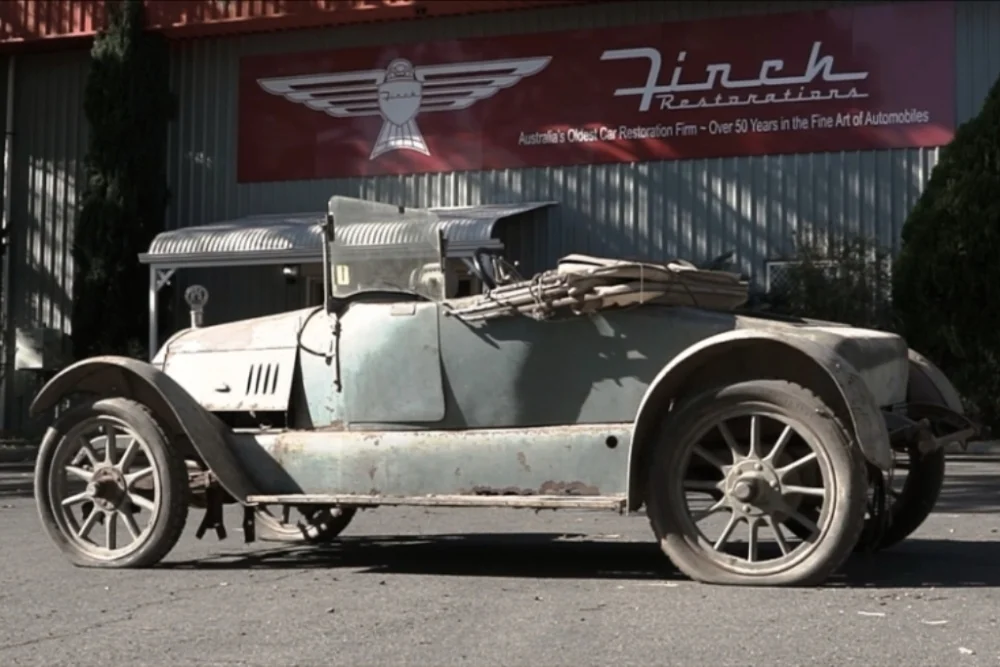| 1910 Napier Type 31 “Colonial Model” - Two Seat Roadster | |
| Chassis Number | 7614 |
| Engine Number | 16994 |
| Inline 4 Cylinder | 2700 cc | 164.8 cu in. | 2.7 L. |
| 15 HP | |
| Transmission | 3 Speed Manual |
The 'Anti-Clockwise' Car
1910 Napier Type 31 “Colonial Model” - Two Seat Roadster
| 1910 Napier Type 31 “Colonial Model” - Two Seat Roadster | |
| Chassis Number | 7614 |
| Engine Number | 16994 |
| Inline 4 Cylinder | 2700 cc | 164.8 cu in. | 2.7 L. |
| 15 HP | |
| Transmission | 3 Speed Manual |
Napier History
Founded in 1808, D. Napier & Son Limited was a British precision engineering company best known through the early to mid-20th century for its luxury motor cars and aero engines. The company manufactured a diverse range of engine types before introducing the world's first commercially successful six cylinder engine in 1904 and then moving into the luxury car market. They swiftly forged a formidable reputation thanks to their racing and record breaking exploits.
Napier manufactured just under 10,000 vehicles between 1900 and 1924. Out of this total production only 100 or so vehicles are known to survive mainly in Australia and the UK.
Napier was successful in the early days of motor racing and competed in the Tourist Trophy and the French Grand Prix. It’s Lion aero engine was later used by several land speed record heroes including Malcolm Campbell's Napier-Campbell Blue Bird of 1927 and Campbell-Napier-Railton Blue Bird of 1931, Segrave's Golden Arrow of 1929, and John Cobb's Napier-Railton and Railton Mobil Special, which held the record from 1939–64.
Outside the racing program, Napier also gained fame in 1904 by being the first car to cross the Canadian Rockies: Mr. and Mrs. Charles Glidden, sponsors of the Glidden Tours, covered 3,536 miles from Boston to Vancouver.
The 1910 15hp was developed from the earlier 15hp model launched in 1907 and was a sister model to the huge sixes that had established Napier's reputation. It was this four-cylinder 15hp introduced at Olympia in 1910 that was to become the company's most successful model. It cost £350 in chassis form, to which Napier's own four-seater bodywork added an extra £80 (plus an extra £7 for the windscreen).
The 15hp 'Colonial' model was produced especially for those countries where rough roads prevailed, particularly Australia, but also New Zealand, Canada, and South Africa. The 'Colonial' model featured raised suspension, larger wheels and an engine installed 'back to front' so that the large flywheel was protected by the front axle. As the flywheel rotated in the opposite direction to other Napier models, it was dubbed the 'Anti-Clockwise' model.
During October 1912 Walter Trevethan of Queensland set a record of 3 hours 7 minutes driving from Brisbane to Toowoomba, demonstrating the Napier's suitability for Australia's country roads.
The Project
The vehicle was owned by the very creative and renowned architect, Mr Frank Hurren, a collector of motor vehicles and other antiquities. In a conversation in March 1996 with Bill Bishop, a South Australian member of the Napier Power Heritage Trust, Frank told Bill that the car was previously owned by Gavin Sandford-Morgan, Rick Howard and Alfred Hughes who then sold it to Frank. A copy of the receipt from Alfred B. Hughes on the 14th of April, 1949 for the price of £30 is held, and a copy is is shown in the image gallery. Apparently the car was found in a barn near Jamestown with the 1919 roadster body. When in Jamestown, it belonged to a Mr/Mrs Innes.
The Napier is also mentioned in an article by Gavin Sandford-Morgan in the December 1953 edition of the Motor Sport magazine (see image gallery). Analysis of the article suggests that the vehicle was (probably) originally delivered into South Australia and then retrofitted with a 'modern' body in 1919. The article also mentions the car being found, year unknown, "150 miles from Adelaide coroborating Bill Bishop's conversation.
Gavin Sandford-Morgan's article describes the car as being a 1909 10HP model, however Clive Boothman, Chairman of the Napier Power Heritage Trust in the UK advises that the Trust's survivor records indicate that this car left Napier's Acton works in September 1910 and is a Type 31 model. Photos supplied by Clive are included in the gallery below and show the car in South Australia in March 1949 just prior to being sold to Frank Hurren. Presumably, then owner Alfred Hughes is depicted in the photos. Clive has also provided the catalogue/brochure images of the 15HP 'Noiseless' Napier. The specification sheets contains a fascinating list of 'celebrity' owners of the 15HP Napier including, for instance, the King of Siam.
Thanks to the careful dry storage since its last registration in 1953, the vehicle is in remarkable, complete and untouched (since 1919) condition, suffering primarily from some body rust. From viewing our video documentary, you will see the Napier being moved from its long term resting place.
The new owner wanted Finch Restorations to restore sympathetically and maintain much of the patina as is practicable, choosing only to restore the mechanicals to ensure reliable and safe operation.

